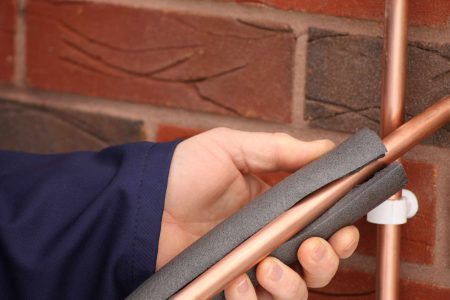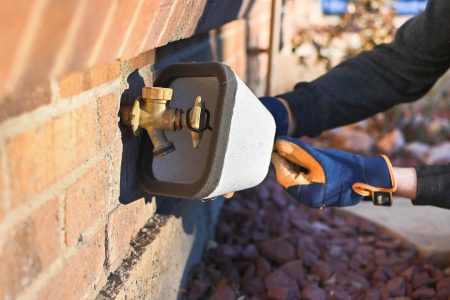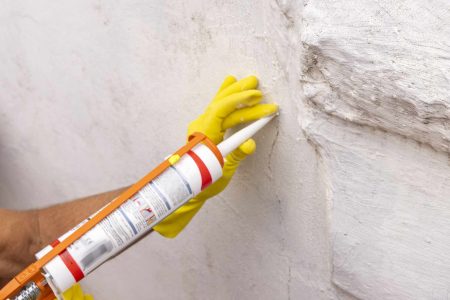You may have seen beautiful displays of veneer stone or natural stone on the walls of homes or businesses. If you have a difficult time telling veneer stone apart from natural stone, that is entirely by the manufacturers’ design.
The veneer stone industry is doing its best to displace natural stone as the masonry covering of choice for home exterior cladding, fireplace surrounds, and all sorts of interior touches. How can you tell the two apart? Which stone product should you purchase and install for your home cladding, fireplace, wainscot, and other architectural details?
What Is Veneer Stone?
Veneer stone, architectural stone, manufactured stone, and Cultured Stone (a Boral company trademark often used to indicate manufactured stone) are different names for what is essentially the same product: engineered stone meant to look like natural stone.
This product is a slurry of Portland cement, aggregates, and iron oxides baked in textured molds to look like stone. Cement lends stability to the product and iron oxides provide pigments. Veneer stone should not be confused with faux veneer stone, a high-density polymer product that feels closer to Styrofoam than to stone.
-
Lightweight
-
Easy to cut
-
Easy to obtain
-
Homogeneous appearance
-
Color may fade
-
Brittle
What Is Natural Stone?
Natural stone, of the type that is used in homes, is 100-percent stone quarried straight from the earth, with nothing added or removed and no color additives. Natural stone can be wholly real in shape, such as rounded river stones. Or natural stone can be carved to the desired shape, such as blocks for building, sheets for walls, or tiles for flooring.
-
Popular appearance
-
Durable
-
Colorfast
-
Heavy and dense
-
Hard to cut
-
Difficult to source
Watch Now: Veneer Stone vs Natural Stone
Structural Use
Manufactured veneer stone is too weak to be used structurally for building purposes. Veneer stone can hold up its own weight, but it cannot carry additional weight. Veneer stone is never used for flooring. Real stacked stone is never found with veneer stone since veneer stone is just that: a veneer. However, veneer stone can successfully mimic the look of stacked stone.
Natural stone can be used structurally, though this is becoming a rare practice in modern building. When you want authentic stacked stone, you must use natural stone. Some natural stone, such as slate, is too brittle for structural uses. Natural stone, such as travertine, is commonly used for pathways, flooring, and walls.
Size, Weight, and Thickness
Full-dimension veneer stone starts at around two inches thick and increases to around six to eight inches thick. A sub-category called thin stone veneer ranges from 1-inch to 2-inch thick. Veneer stone face sizes can be as large as 14 inches in diameter. Veneer stone is about half the weight of natural stone of the same size.
Natural stone on the wide consumer market mostly comes in two sizes. Full-size blocks approximately the size of one or two retaining wall blocks can provide full-dimension coverage and the stacked look that many homeowners desire. For a veneer-style cover, natural stone is quarried and then cut into slices with an industrial-size, similar to a wet tile saw.
Though veneer, this is still 100-percent natural stone and measures about 3/4-inch to 1 3/4-inch thick. Face sizes for natural stone depend on the type of stone but tend to stop at around 18 inches in diameter. Natural stone is far heavier than veneer stone. For example, natural fieldstone is about 13 pounds per square foot, more than twice the weight of manufactured veneer stone.
Appearance and Color Fastness
Veneer stone’s colors can fade over time. Inexpensive, inferior manufactured stone can be a tempting purchase, but often, its appearance is lacking. It can have highly repetitive patterns (or monochromatic colors) and be as little as one inch in thickness. Be sure to read the manufacturer’s specifications before purchasing and order samples. With veneer stone, quality tends to be consistent.
Natural stone is never repetitive, and generally it has a pleasing appearance. Quality can sharply vary, though. Natural stone’s colors can fade with sunlight but at such slow rates that it will not be noticed within a person’s lifetime.
Installation Procedures
Manufactured veneer stone installs with lath, a scratch coat, mortar, and grout or no grout for the dry-stack appearance. In terms of installation, the main differences between manufactured veneer stone and natural stone are weight and density. Manufactured stone is far easier to handle and to cut than natural stone because it is porous and lightweight. Manufactured veneer stone lends itself to do-it-yourself installation more so than does natural stone.
Natural stone can be installed directly on porous concrete, stone, or block. If the surface is smooth, you can attach metal lath and a scratch masonry coat to provide a surface for thin sheets of stone to grip. Grout is added between the stones. Alternatively, the stones can go grout-free for a dry-stack appearance. Natural stone cannot be installed on drywall or other thin materials. Due to its density, natural stone is difficult to cut.
What Is Metal Lath?
Metal lath is generally a type of mesh made out of a metal sheet. It forms a rigid, irregular surface, which is ideal for adhering stucco, plaster, stone, and other materials.
Manufacturers and Suppliers
The list of manufactured veneer stone companies increases all the time as the popularity of this product increases. Well-known manufacturers of veneer stone include:
- Boulder Creek Stone Products
- Coronado Stone Products
- Cultured Stone (Boral America)
- El Dorado (Boral America)
- Stonecraft (Boral America)
Suppliers of natural stone tend to be local since the cost of shipping to individual buyers can be prohibitive.
Should You Install Veneer Stone or Natural Stone?
Why use man-made veneer stone if the resulting product is more homogeneous than natural stone? And why do this if the installation process is roughly the same between the two?
Predictability is one reason why DIYers prefer manufactured veneer stone over natural stone. Manufactured veneer stone comes in predictable sizes that are easy to carry, cut, and hang. For faster installation, some manufactured stone products install as larger square panels (2-foot by 2-foot) and with no need for mortar or grout.
For high-end or historically accurate installations, natural stone may be your best choice.
Read the full article here









